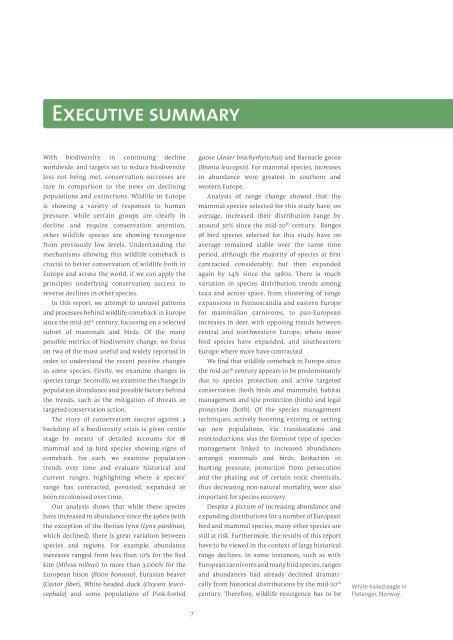130925-studie-wildlife-comeback-in-europe
You also want an ePaper? Increase the reach of your titles
YUMPU automatically turns print PDFs into web optimized ePapers that Google loves.
Executive summary<br />
With biodiversity <strong>in</strong> cont<strong>in</strong>u<strong>in</strong>g decl<strong>in</strong>e<br />
worldwide, and targets set to reduce biodiversity<br />
loss not be<strong>in</strong>g met, conservation successes are<br />
rare <strong>in</strong> comparison to the news on decl<strong>in</strong><strong>in</strong>g<br />
populations and ext<strong>in</strong>ctions. Wildlife <strong>in</strong> Europe<br />
is show<strong>in</strong>g a variety of responses to human<br />
pressure: while certa<strong>in</strong> groups are clearly <strong>in</strong><br />
decl<strong>in</strong>e and require conservation attention,<br />
other <strong>wildlife</strong> species are show<strong>in</strong>g resurgence<br />
from previously low levels. Understand<strong>in</strong>g the<br />
mechanisms allow<strong>in</strong>g this <strong>wildlife</strong> <strong>comeback</strong> is<br />
crucial to better conservation of <strong>wildlife</strong> both <strong>in</strong><br />
Europe and across the world, if we can apply the<br />
pr<strong>in</strong>ciples underly<strong>in</strong>g conservation success to<br />
reverse decl<strong>in</strong>es <strong>in</strong> other species.<br />
In this report, we attempt to unravel patterns<br />
and processes beh<strong>in</strong>d <strong>wildlife</strong> <strong>comeback</strong> <strong>in</strong> Europe<br />
s<strong>in</strong>ce the mid-20 th century, focuss<strong>in</strong>g on a selected<br />
subset of mammals and birds. Of the many<br />
possible metrics of biodiversity change, we focus<br />
on two of the most useful and widely reported <strong>in</strong><br />
order to understand the recent positive changes<br />
<strong>in</strong> some species. Firstly, we exam<strong>in</strong>e changes <strong>in</strong><br />
species range. Secondly, we exam<strong>in</strong>e the change <strong>in</strong><br />
population abundance and possible factors beh<strong>in</strong>d<br />
the trends, such as the mitigation of threats or<br />
targeted conservation action.<br />
The story of conservation success aga<strong>in</strong>st a<br />
backdrop of a biodiversity crisis is given centre<br />
stage by means of detailed accounts for 18<br />
mammal and 19 bird species show<strong>in</strong>g signs of<br />
<strong>comeback</strong>. For each, we exam<strong>in</strong>e population<br />
trends over time and evaluate historical and<br />
current ranges, highlight<strong>in</strong>g where a species’<br />
range has contracted, persisted, expanded or<br />
been recolonised over time.<br />
Our analysis shows that while these species<br />
have <strong>in</strong>creased <strong>in</strong> abundance s<strong>in</strong>ce the 1960s (with<br />
the exception of the Iberian lynx (Lynx pard<strong>in</strong>us),<br />
which decl<strong>in</strong>ed), there is great variation between<br />
species and regions. For example, abundance<br />
<strong>in</strong>creases ranged from less than 10% for the Red<br />
kite (Milvus milvus) to more than 3,000% for the<br />
European bison (Bison bonasus), Eurasian beaver<br />
(Castor fiber), White-headed duck (Oxyura leucocephala)<br />
and some populations of P<strong>in</strong>k-footed<br />
goose (Anser brachyrhynchus) and Barnacle goose<br />
(Branta leucopsis). For mammal species, <strong>in</strong>creases<br />
<strong>in</strong> abundance were greatest <strong>in</strong> southern and<br />
western Europe.<br />
Analysis of range change showed that the<br />
mammal species selected for this study have, on<br />
average, <strong>in</strong>creased their distribution range by<br />
around 30% s<strong>in</strong>ce the mid-20 th century. Ranges<br />
of bird species selected for this study have on<br />
average rema<strong>in</strong>ed stable over the same time<br />
period, although the majority of species at first<br />
contracted considerably, but then expanded<br />
aga<strong>in</strong> by 14% s<strong>in</strong>ce the 1980s. There is much<br />
variation <strong>in</strong> species distribution trends among<br />
taxa and across space, from cluster<strong>in</strong>g of range<br />
expansions <strong>in</strong> Fennoscandia and eastern Europe<br />
for mammalian carnivores, to pan-European<br />
<strong>in</strong>creases <strong>in</strong> deer, with oppos<strong>in</strong>g trends between<br />
central and northwestern Europe, where more<br />
bird species have expanded, and southeastern<br />
Europe where more have contracted.<br />
We f<strong>in</strong>d that <strong>wildlife</strong> <strong>comeback</strong> <strong>in</strong> Europe s<strong>in</strong>ce<br />
the mid-20 th century appears to be predom<strong>in</strong>antly<br />
due to species protection and active targeted<br />
conservation (both birds and mammals), habitat<br />
management and site protection (birds) and legal<br />
protection (both). Of the species management<br />
techniques, actively boost<strong>in</strong>g exist<strong>in</strong>g or sett<strong>in</strong>g<br />
up new populations, via translocations and<br />
re<strong>in</strong>troductions, was the foremost type of species<br />
management l<strong>in</strong>ked to <strong>in</strong>creased abundances<br />
amongst mammals and birds. Reduction <strong>in</strong><br />
hunt<strong>in</strong>g pressure, protection from persecution<br />
and the phas<strong>in</strong>g out of certa<strong>in</strong> toxic chemicals,<br />
thus decreas<strong>in</strong>g non-natural mortality, were also<br />
important for species recovery.<br />
Despite a picture of <strong>in</strong>creas<strong>in</strong>g abundance and<br />
expand<strong>in</strong>g distributions for a number of European<br />
bird and mammal species, many other species are<br />
still at risk. Furthermore, the results of this report<br />
have to be viewed <strong>in</strong> the context of large historical<br />
range decl<strong>in</strong>es. In some <strong>in</strong>stances, such as with<br />
European carnivores and many bird species, ranges<br />
and abundances had already decl<strong>in</strong>ed dramatically<br />
from historical distributions by the mid-20 th<br />
century. Therefore, <strong>wildlife</strong> resurgence has to be<br />
White-tailed eagle <strong>in</strong><br />
Flatanger, Norway.<br />
7


